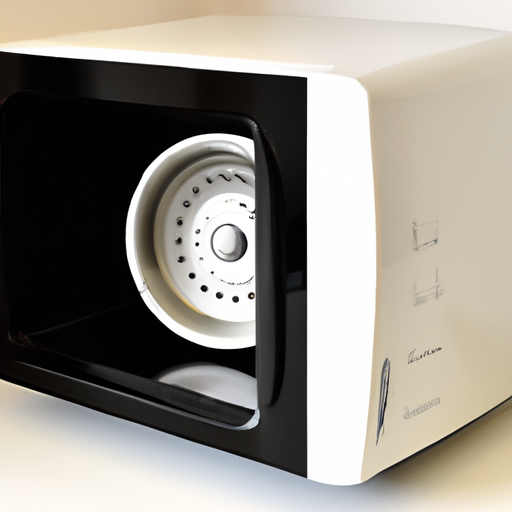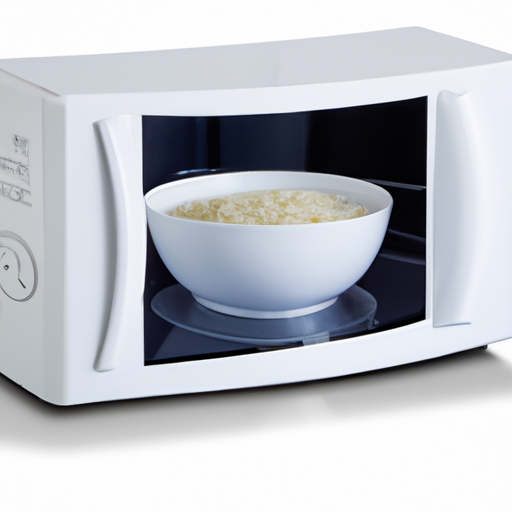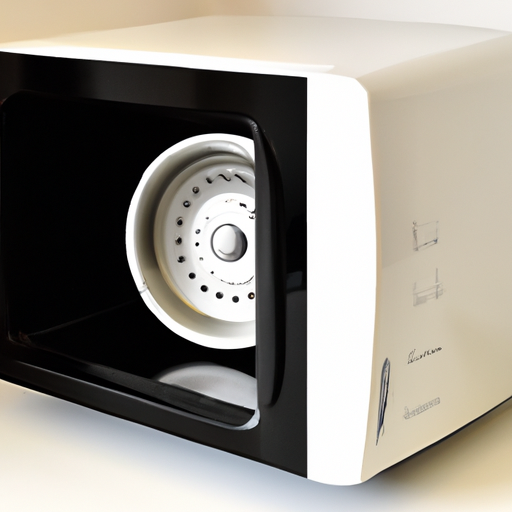Are you tired of constantly guessing the cooking times for your favorite meals in the microwave? Look no further! “Microwave Cooking Times and Tips” has got you covered. With its handy microwave cooking chart, you’ll never have to endure another overcooked or undercooked meal again. This product is designed to provide you with precise cooking times and helpful tips, ensuring that your food comes out perfectly cooked every time. Say goodbye to the frustration of trial and error, and say hello to effortless microwave cooking with “Microwave Cooking Times and Tips.”
Understanding Microwave Cooking
Microwave cooking has become increasingly popular due to its convenience and time-saving capabilities. By understanding how microwaves cook food, you can make the most out of this kitchen appliance and create delicious meals.
How Microwaves Cook Food
Microwaves work by emitting electromagnetic waves that penetrate the food and excite the water molecules within it. As these molecules become agitated, they generate heat, which ultimately cooks the food. Unlike traditional cooking methods that heat the air around the food, microwaves directly heat the food itself.
Benefits of Microwave Cooking
Microwave cooking offers several benefits that make it a convenient choice for many individuals. Firstly, it significantly reduces cooking time compared to conventional methods, allowing you to whip up meals in a fraction of the time. Additionally, it is energy-efficient, consuming less power than other appliances. Microwave cooking also requires minimal supervision, allowing you to multitask while your food cooks. Finally, it preserves the nutrients in your food better than other cooking methods, as the shorter cooking time minimizes nutrient loss.
Microwave-Safe Containers
Using the right containers in the microwave is crucial to ensure safe and efficient cooking. Microwave-safe containers are specially designed to withstand the heat and energy emitted by microwaves. These containers are typically made of glass, ceramic, or microwave-safe plastic. Avoid using containers that are not labeled as microwave-safe, as they may release harmful chemicals into your food or even melt in the microwave. Always check the packaging or look for the microwave-safe symbol before using any container in the microwave.
Recommended Microwave Cooking Times
Knowing the appropriate cooking times for different foods is key to achieving optimal results in the microwave. While cooking times can vary depending on the wattage of your microwave, using a microwave cooking time chart can serve as a helpful reference.
Microwave Cooking Time Charts
Microwave cooking time charts provide a general guideline for cooking various foods in the microwave. They typically include recommended cooking times for different types of meat, poultry, fish, vegetables, rice, grains, baking, and reheating leftovers. It is important to note that these charts are based on average wattages, so you may need to adjust the cooking time accordingly for your specific microwave.
Factors Affecting Cooking Times
Several factors can influence cooking times in the microwave. The size and thickness of the food item play a significant role, as thicker pieces will require more time to cook thoroughly. Starting temperature also affects cooking times, as colder food will take longer to heat through. Additionally, the wattage of your microwave can impact cooking times, with higher wattages generally requiring shorter cooking times.
Tips for Adjusting Cooking Times
If you find that your food is consistently undercooked or overcooked in the microwave, it may be necessary to adjust the cooking time. This adjustment can be done by either increasing or decreasing the cooking time until you achieve the desired results. It is recommended to make small adjustments and test the food’s doneness by using a food thermometer or visually checking for signs of doneness.

Cooking Different Food Items
Microwave cooking is incredibly versatile and can be used to prepare a wide variety of food items. Here are some tips for cooking different types of food in the microwave:
Meat and Poultry
When cooking meat and poultry in the microwave, it is important to ensure that it reaches a safe internal temperature to avoid the risk of foodborne illnesses. Use a meat thermometer to check for doneness, ensuring that the temperature reaches the recommended level. It is also advisable to use microwave-safe containers that allow for even cooking and prevent splattering.
Fish and Seafood
Fish and seafood can be easily cooked in the microwave, preserving their flavors and textures. To prevent overcooking and maintain moisture, cover the fish or seafood with a microwave-safe lid or wrap it in microwave-safe plastic wrap. It is also essential to follow cooking times and adjust accordingly to avoid dryness.
Vegetables
Microwaving vegetables is a quick and convenient way to retain their nutrients and vibrant colors. To prevent overcooking, use a microwave-safe vegetable steamer or a microwave-safe dish with a lid. It is best to add a minimal amount of water or sprinkle some water on top of the vegetables to aid in the steaming process.
Rice and Grains
Cooking rice and grains in the microwave is a time-saving alternative to stovetop methods. It is important to use the appropriate ratio of water to rice or grains to ensure proper cooking. Cover the container with a microwave-safe lid or microwave-safe plastic wrap to trap steam and achieve fluffy results. Stir the rice or grains halfway through the cooking time for even heat distribution.
Baking and Desserts
While microwaves are not typically associated with baking, they can be used to create delicious desserts in a fraction of the time. Use microwave-safe baking dishes or silicone molds specifically designed for microwave use. Remember to adjust the cooking time and power level based on the recipe’s instructions to prevent overcooking or undercooking.
Reheating Leftovers
Microwaves are excellent for reheating leftovers, helping you enjoy a warm meal in minutes. To ensure even heating, cover the leftovers with a microwave-safe lid or microwave-safe plastic wrap. Stir the food occasionally during the reheating process to distribute heat evenly.
Tips for Successful Microwave Cooking
To achieve the best results when cooking in the microwave, consider the following tips:
Covering Food for Even Cooking
Covering food with a microwave-safe lid or microwave-safe plastic wrap helps trap steam and maintains moisture levels, resulting in more even cooking.
Stirring and Rotating Food
Stirring and rotating food during the cooking process promotes even heat distribution, preventing hot spots and ensuring that all parts of the dish are cooked uniformly.
Using Microwave-Specific Cookware
Using cookware specifically designed for microwave use helps to distribute heat evenly and prevent damage to the microwave. Avoid using metal cookware, as it can cause sparks and damage the appliance.
Piercing or Pricking Food
Piercing or pricking certain foods, such as potatoes or egg yolks, with a fork or toothpick before microwaving helps to release steam and prevent them from exploding during cooking.
Arranging Food for Uniform Cooking
Properly arranging food in the microwave helps to ensure even cooking. For example, placing thicker parts of meat towards the outer edges and thinner parts towards the center helps them cook more uniformly.
Using Microwave Power Levels
Most microwaves offer different power levels that allow you to control cooking intensity. Lower power levels are useful for defrosting, simmering, or cooking more delicate foods, while higher power levels are ideal for quickly heating or cooking denser foods.

Avoiding Common Microwave Cooking Mistakes
While microwave cooking is generally easy and convenient, there are some common mistakes that can affect the quality of your food. By being aware of these mistakes, you can avoid them and achieve excellent microwave-cooked meals.
Overcooking and Dryness
One of the most prevalent mistakes in microwave cooking is overcooking, leading to dry and tough food. To prevent this, carefully monitor cooking times and reduce them if necessary. Microwaves vary in power, so it is important to adjust cooking times accordingly.
Undercooking and Safety Issues
Undercooking food in the microwave not only affects its taste and texture but also poses safety risks. Make sure to check that your food reaches the appropriate internal temperature for each type of food to eliminate any harmful bacteria.
Losing Nutritional Value
Overcooking or heating food for extended periods in the microwave can result in nutrient loss. To preserve the nutritional value, follow recommended cooking times, use microwave-safe covers, and avoid excessive cooking.
Uneven Heating
Inadequate stirring or improper placement of food in the microwave can lead to uneven heating. Take the time to stir and rotate food during cooking to ensure all parts are evenly heated.
Reheating Food More Than Once
While it may be tempting to repeatedly reheat leftovers, doing so can result in overcooking and waste valuable nutrients. Reheat food only once, and avoid storing leftovers for extended periods to maintain quality.
Additional Microwave Cooking Tips
To make the most out of your microwave cooking experience, consider the following additional tips:
Proper Food Placement in Microwave
Placing larger food items towards the outer edges of the microwave and smaller items towards the center ensures better exposure to the microwave’s energy, promoting more even cooking.
Using Microwave-Safe Covers
Using microwave-safe covers, such as microwave splatter guards or microwave-safe glass lids, helps to contain steam, prevent splatters, and retain moisture during cooking.
Accelerating Cooking with Microwave-Safe Tools
Certain tools, such as microwave-safe steaming bags or microwave-safe silicone steamers, can speed up the cooking process by promoting steam circulation and efficient heat transfer.
Using Microwave to Defrost Food
Defrosting food in the microwave is a convenient and time-saving method. Use the defrost setting or a lower power level to ensure even defrosting without cooking the outer edges.
Choosing the Right Size Microwave for Cooking Needs
Consider the size and capacity of the microwave when purchasing a new one. A larger microwave allows you to cook more substantial portions, while a smaller one may be more suitable for smaller households or limited counter space.
Cleaning and Maintaining Your Microwave
Proper maintenance and cleaning of your microwave are essential to keep it running efficiently and maintain food safety.
Cleaning Techniques
To clean your microwave, start by wiping down the interior with a soft cloth or sponge soaked in a mixture of mild dish soap and warm water. Avoid using abrasive cleaners or scrub brushes, as they can damage the microwave’s interior. For stubborn stains or odors, you can also heat a bowl of water with lemon slices or vinegar in the microwave for a few minutes to help loosen dirt and eliminate odors.
Removing Odors
If your microwave has developed unpleasant odors from previous cooking, there are a few natural remedies you can try. Heating a bowl of water with a few tablespoons of baking soda or lemon juice can help neutralize odors. Additionally, placing a bowl of activated charcoal or coffee grounds inside the microwave overnight can absorb unwanted smells.
Avoiding Damage
To prevent damage to your microwave, avoid using metal utensils or containers that are not microwave-safe. Metal can cause sparks and potentially damage the appliance. Additionally, be cautious when microwaving foods with high sugar or fat content, as they can cause splattering and leave difficult-to-clean residue.
Maintenance Checklist
Regularly check the seals and hinges of your microwave to ensure they are intact and functioning properly. Clean the exterior regularly with a gentle cleaner to remove any grease or dirt buildup. Finally, follow the manufacturer’s instructions for any additional maintenance specific to your microwave model.
Understanding Microwave Wattage
Understanding the wattage of your microwave is important when it comes to adjusting cooking times and achieving desired results.
Determining Microwave Wattage
To determine the wattage of your microwave, check the owner’s manual or look for a label on the microwave itself. If the wattage is not specified, you can perform a simple test by heating a known quantity of water in a microwave-safe container for a specified time and measuring the increase in temperature. There are also online resources that can help you estimate the wattage based on the microwave’s model and age.
Adjustments for Different Wattages
Cooking times may vary depending on the wattage of your microwave. Higher wattages generally require shorter cooking times, while lower wattages may require longer cooking times. If a recipe’s cooking instructions are based on a different wattage, you may need to adjust the cooking time accordingly. Use a microwave cooking time chart as a reference and make slight modifications based on your microwave’s wattage.
Microwave Power Variations
Some microwaves offer the ability to adjust power levels, allowing you to vary the intensity of the microwave’s energy. Lower power levels are ideal for defrosting or heating delicate foods, while higher power levels are suitable for quickly heating or cooking denser foods. Experiment with different power levels to achieve the desired cooking results.
Microwave Cooking Safety Precautions
While microwaves are generally safe to use, it is important to follow certain safety precautions to ensure your well-being and prevent accidents.
Proper Microwaving of Raw Food
When microwaving raw food, it is crucial to ensure it reaches the proper internal temperature to eliminate harmful bacteria. Use a food thermometer to check for doneness, and follow recommended cooking times to ensure thorough cooking.
Avoiding Superheating
Superheating can occur when liquids in the microwave exceed their boiling point without visibly bubbling. To prevent superheating, place a microwave-safe utensil, such as a wooden stir stick or a microwave-safe spoon, in the container when heating liquids. This will help create nucleation points, allowing bubbles to form and preventing sudden eruption when the container is disturbed.
Preventing Burns
Microwaved food containers and plates can become hot during the cooking process, leading to burns. Use oven mitts or microwave-safe gloves when handling hot items, and be cautious when removing covers or lifting containers from the microwave.
Child Safety Measures
If you have young children, it is important to take extra precautions to ensure their safety around the microwave. Keep the microwave out of their reach, and teach them about the potential dangers associated with microwaves, including hot surfaces and steam. Always supervise children when using the microwave.
Exploring Advanced Microwave Techniques
While the microwave is commonly associated with reheating and quick cooking, there are advanced techniques that can be explored to expand your culinary possibilities.
Microwave Steam Cooking
Microwave steam cooking is an excellent way to retain nutrients and flavors in vegetables, fish, and other delicate foods. Use microwave-safe steamer bags or microwave-safe steamers to achieve tender and nutritious results.
Microwave Sous Vide Cooking
Sous vide, a cooking technique using precise temperature control, can also be replicated in the microwave. Using microwave-safe bags or containers, you can cook vacuum-sealed food items at low temperatures for extended periods, resulting in tender and flavorful dishes.
Microwave Grilling
Although grilling traditionally involves an open flame or hot coals, a microwave can simulate grilling by utilizing its combination cooking features. By using a microwave-safe grill pan or rack, you can achieve grill-like marks and flavors on meats, vegetables, and even sandwiches.
Microwave Roasting
Roasting is typically done in an oven, but the microwave can offer a quicker alternative. By using microwave-safe roasting bags or dishes with lids, you can achieve tender and flavorful roasted meats and vegetables in a fraction of the time.
Microwave Baking
While baking may be more commonly associated with conventional ovens, microwaves can also be used for certain baking tasks. Microwave-safe baking dishes and silicone molds designed for microwave use allow you to create a variety of desserts and baked goods.
In conclusion, microwave cooking is a convenient and efficient way to prepare a wide range of dishes. By understanding the principles of microwave cooking, following recommended cooking times, and employing various techniques, you can achieve delicious and nutritious meals with ease. Remember to prioritize safety and proper maintenance to ensure your microwave continues to serve you well. So go ahead, explore the possibilities of microwave cooking and enjoy the convenience it offers in your kitchen.
